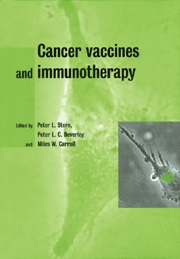Book contents
- Frontmatter
- Contents
- List of contributors
- 1 Immunity and cancer
- 2 Immunotherapy of bladder cancer
- 3 Poxviruses as vectors for cancer immunotherapy
- 4 Vaccinia-based human papillomavirus vaccines in cervical cancer
- 5 Vaccine delivery and immunosuppression in cervical cancer
- 6 Vaccines for colon cancer
- 7 MUC1 vaccines and breast cancer
- 8 Anti-idiotypic vaccination
- 9 Immunotherapy and vaccination against Epstein–Barr virus-associated cancer
- 10 Serologically identified tumour antigens as cancer vaccines
- 11 CTL-defined cancer vaccines in melanoma and other epithelial cancers
- 12 DNA vaccines against B-cell tumours
- 13 Dendritic cell approaches to immunotherapy
- 14 Overview
- 15 Recent developments
- Index
1 - Immunity and cancer
Published online by Cambridge University Press: 06 January 2010
- Frontmatter
- Contents
- List of contributors
- 1 Immunity and cancer
- 2 Immunotherapy of bladder cancer
- 3 Poxviruses as vectors for cancer immunotherapy
- 4 Vaccinia-based human papillomavirus vaccines in cervical cancer
- 5 Vaccine delivery and immunosuppression in cervical cancer
- 6 Vaccines for colon cancer
- 7 MUC1 vaccines and breast cancer
- 8 Anti-idiotypic vaccination
- 9 Immunotherapy and vaccination against Epstein–Barr virus-associated cancer
- 10 Serologically identified tumour antigens as cancer vaccines
- 11 CTL-defined cancer vaccines in melanoma and other epithelial cancers
- 12 DNA vaccines against B-cell tumours
- 13 Dendritic cell approaches to immunotherapy
- 14 Overview
- 15 Recent developments
- Index
Summary
Introduction
As early as the turn of the century, Paul Erhlich suggested that ‘aberrant germs’ (tumours) occurred at a high frequency in all humans but were kept in check by the immune system. Developments in understanding of the protective roles of antibodies and phagocytes in infectious disease in the early years of the century led to attempts to stimulate the immune system to reject tumours. The New York surgeon, Coley, used bacterial vaccines to cause a ‘commotion in the blood’ and occasional regressions following treatment or occurring spontaneously were taken as evidence of an effective immune response.
Early experimental work demonstrated that transplanted (allogeneic) tumours usually regressed. However, it was soon realized that this was a consequence of the genetic disparity of host and tumour and was revealing immune responses to foreign tissue transplants, not tumour antigens. However, what these early studies did show was that a strong immune response could prevent the growth of a tumour and cure the animal.
Immune surveillance
In the 1950s, Burnett and Thomas restated Erhlich's idea as the theory of ‘immune surveillance’. It was proposed that the immune system was able to recognize abnormal cells, which were destroyed before they could develop into a tumour. Since tumours do develop in many individuals it was also suggested that the immune system played a role in delaying growth or causing regression of established tumours.
- Type
- Chapter
- Information
- Cancer Vaccines and Immunotherapy , pp. 1 - 18Publisher: Cambridge University PressPrint publication year: 2000



